
A roller coaster is a type of amusement ride employing a form of elevated railroad track that carries passengers on a train through tight turns, steep slopes, and other elements designed to produce a thrilling experience. Trains consist of open cars connected in a single line, and the rides are often found in theme parks around the world. Roller coasters first appeared in the 17th century, and LaMarcus Adna Thompson obtained one of the first known patents for a roller coaster design in 1885, based on the Switchback Railway which opened a year earlier at Coney Island.
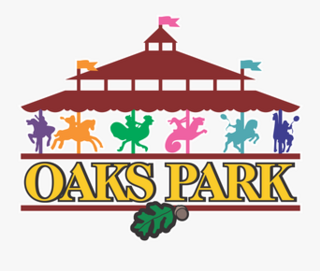
Oaks Park is a small amusement park located 3.5 miles (5.6 km) south of downtown Portland, Oregon, United States. The park opened in May 1905 and is one of the oldest continually operating amusement parks in the country.

A roller coaster train is a vehicle made up of two or more cars connected by specialized joints which transports passengers around a roller coaster's circuit. Roller coasters usually have various safety features, including specialized wheels and restraints.
Harry Guy Traver was an American engineer and early roller coaster designer. As the founder of the Traver Engineering Company, Traver was responsible for the production of gentle amusement rides like the Tumble Bug and Auto Ride. His roller coasters became legendary for their unique twisted layouts and thrilling, swooped turns. At a time when most coasters were built from wood, Traver was the first coaster builder to utilize steel for the primary structural material. He also built the first motorized fire engine in New York City.
John A. Miller was an American roller coaster designer and builder, inventor, and businessman. Miller patented over 100 key roller coaster components, and is widely considered the "father of the modern high-speed roller coaster." During his lifetime, he participated in the design of approximately 150 coasters and was a key business partner and mentor to other well-known roller coaster designers, Harry C. Baker and John C. Allen.

The Crystal Beach Cyclone was one of a 'Terrifying Triplet' of highly extreme and intense roller coasters designed and built by Harry G. Traver in the late 1920s. The Cyclone was located at the Crystal Beach Park in Ontario, Canada.
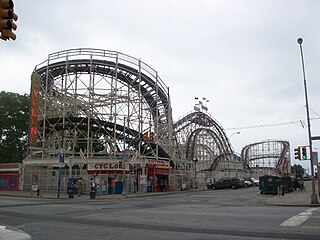
Roller coaster amusement rides have origins back to ice slides constructed in 18th-century Russia. Early technology featured sleds or wheeled carts that were sent down hills of snow reinforced by wooden supports. The technology evolved in the 19th century to feature railroad track using wheeled cars that were securely locked to the track. Newer innovations emerged in the early 20th century with side friction and underfriction technologies to allow for greater speeds and sharper turns. By the mid-to-late 20th century, these elements intensified with the introduction of steel roller coaster designs and the ability to invert riders.

The Cyclone was a wooden roller coaster that operated at Revere Beach in Revere, Massachusetts, from 1925 until 1969. When Cyclone was constructed, it was the tallest roller coaster ever built, as well as being the first roller coaster in the world to reach 100 feet (30 m) in height. In addition to being the tallest roller coaster of its day, some also claim that it was the largest and fastest roller coaster in the world, with a length of 3,600 feet (1,100 m) and top speeds between 45 and 50 mph. Cyclone held the title of world's tallest roller coaster until 1964 when it was surpassed by Montaña Rusa at La Feria Chapultepec Mágico in Mexico City, Mexico.
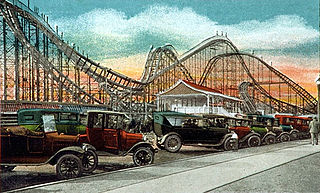
Lightning was a wooden roller coaster that operated from 1927 until 1933 at Revere Beach in Revere, Massachusetts. It was one of the infamous Giant Cyclone Safety Coasters which were constructed by noted roller coaster engineer Harry G. Traver in the mid-1920s. Lightning was the only Giant Cyclone Safety Coaster not to bear the "Cyclone" name, as a roller coaster named Cyclone already existed at Revere Beach when Lightning was constructed in 1927. The other two members of this group of coasters included the Crystal Beach Cyclone and the Palisades Park Cyclone.
Frederick A. Church (1878–1936) was an American engineer and early roller coaster designer. He is most famous for his "Bobs" series of roller coasters that featured severe banking, steep drops, and nonstop action.
Harry C. Baker was an American entrepreneur most notable for his involvement with the construction of roller coasters. Through partnerships and later, as president of the Harry C. Baker Company, Baker would be involved with notable designs such as the Cyclone at Coney Island, the Blue Streak at Woodcliffe Pleasure Park, and Jack Rabbit at Kennywood.
Vernon Keenan (1886-1964) was an American roller coaster designer best known for his involvement with the Cyclone at Coney Island.
Jazz Railway was an early model line of wood roller coasters incorporating a steel-frame structure. These operated at various amusement parks and fairgrounds during the mid to late 1920s. The coaster model is considered to be the first of the Wild Mouse style roller coaster.

The Sesquicentennial Cyclone was a steel-framed wooden roller coaster which was operated at the Philadelphia Sesquicentennial Exposition in 1926. Designed and built by Harry Traver of Traver Engineering, the coaster was a medium-sized prototype of Traver's later Giant Cyclone Safety Coasters.
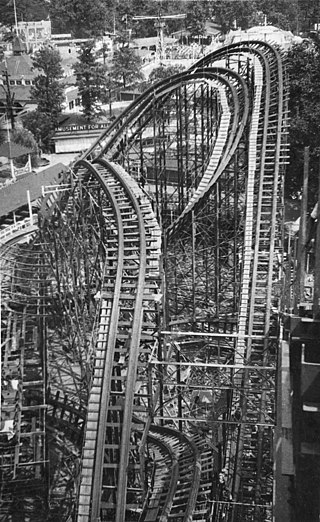
Cyclone was the name of two wooden roller coasters which operated at Palisades Amusement Park in Bergen County, New Jersey, United States. The first operated from 1927 through 1934, and the second between 1945 and 1971.
Giant Cyclone Safety Coasters were a model line of roller coasters designed and marketed by Harry Traver and his company Traver Engineering in the 1920s. Despite their name, they had a reputation of being dangerous and are regarded by many historians as some of the most fearsome roller coasters ever built.

Cannon Coaster, sometimes known as Leap-the-Gap, was a wooden roller coaster which operated on Bowery Street in Coney Island, Brooklyn, New York, in the first decade of the 20th century.

Drop the Dip, later known as Trip to the Moon, was a wooden roller coaster that operated at several locations in Coney Island, Brooklyn, New York, in the early 20th century. The coaster is considered by some to have been the first truly high-speed roller coaster.

Airplane Coaster, known previously as the Aero-Coaster and the Aeroplane Dips, was a wooden roller coaster which operated at Playland Amusement Park in Rye, New York, from 1928 until 1957.
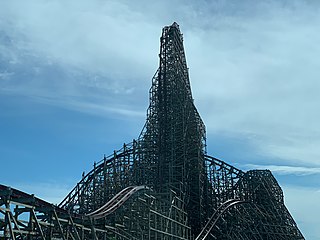
A hybrid roller coaster is a category of roller coasters where the track is made out of one material, either steel or wood, and the support structure is made from another. Early hybrid coasters include mine train roller coasters from Arrow Development, which feature a steel track with a wooden support structure. Becoming increasingly more common are hybrids with wooden tracks and steel supports, such as The Voyage at Holiday World.













